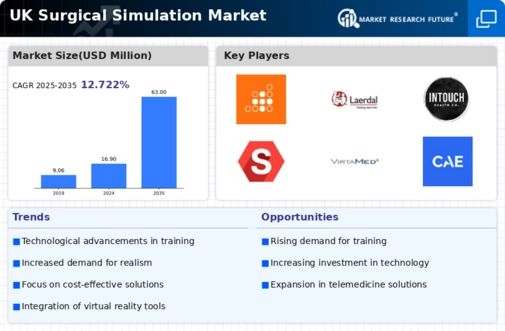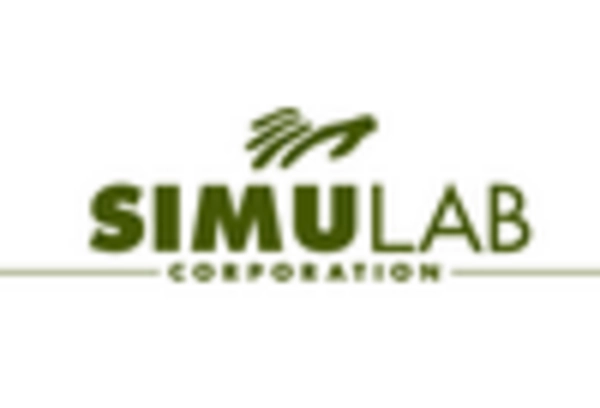Increased Emphasis on Patient Safety
An increased emphasis on patient safety within the UK healthcare system is driving the surgical simulation market. As hospitals and surgical centers strive to minimize errors and enhance the quality of care, the role of simulation in training becomes paramount. Simulation-based training allows surgeons to practice and refine their skills in a risk-free environment, which is essential for maintaining high standards of patient safety. Reports indicate that institutions utilizing surgical simulation have seen a reduction in surgical errors by up to 30%. This focus on safety is likely to drive further investment in the surgical simulation market, as healthcare providers recognize the value of comprehensive training programs.
Collaboration Between Academia and Industry
Collaboration between academic institutions and industry stakeholders is emerging as a key driver for the surgical simulation market in the UK. Partnerships between universities and simulation technology companies facilitate the development of cutting-edge training tools and curricula. This synergy not only enhances the educational experience for medical students and professionals but also accelerates the innovation of simulation technologies. As a result, the surgical simulation market is likely to benefit from a continuous influx of new products and methodologies. These collaborative efforts are expected to lead to a more skilled workforce, ultimately improving surgical outcomes and patient care in the UK.
Technological Advancements in Simulation Tools
Technological advancements are significantly influencing the surgical simulation market in the UK. Innovations such as virtual reality (VR) and augmented reality (AR) are enhancing the realism and effectiveness of surgical training. These technologies allow for immersive experiences that can replicate complex surgical scenarios, thereby improving the learning curve for trainees. The surgical simulation market is expected to witness a surge in investment, with estimates suggesting that the market could reach £1 billion by 2027. This growth is indicative of the increasing recognition of the importance of high-fidelity simulation tools in surgical education and practice, which ultimately leads to better patient safety and surgical outcomes.
Growing Acceptance of Remote Learning Solutions
The surgical simulation market is witnessing a shift towards remote learning solutions, transforming surgical education in the UK. The rise of online platforms and virtual training modules allows for greater accessibility to high-quality simulation resources. This trend is particularly beneficial for healthcare professionals in remote areas, where access to traditional training facilities may be limited. The surgical simulation market is expected to expand as educational institutions and hospitals adopt these innovative training methods. It is estimated that the market could grow by 20% over the next few years, driven by the increasing demand for flexible and accessible training options.
Rising Demand for Minimally Invasive Procedures
The surgical simulation market is experiencing a notable increase in demand for minimally invasive procedures across the UK. This trend is driven by the growing preference for surgeries that result in reduced recovery times and lower risk of complications. As healthcare providers seek to enhance patient outcomes, the adoption of surgical simulation technologies becomes crucial. The market is projected to grow at a CAGR of approximately 15% over the next five years, reflecting the increasing reliance on simulation for training surgeons in these advanced techniques. Furthermore, the integration of simulation in surgical education is likely to improve the proficiency of healthcare professionals, thereby contributing to the overall growth of the surgical simulation market.

















Leave a Comment